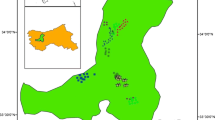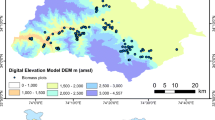Abstract
• Background
The data on carbon pool and biomass distribution pattern of old-growth Pinus kesiya Royle ex. Gordon forests are not available.
• Methods
The forest carbon pool and annual net primary production (NPP) were assessed in three old-growth P. kesiya forest stands in north-eastern India, using biomass equations developed from 40 harvested trees between 9 and 63 cm in diameter at breast height (DBH) range.
• Results
Regression models of the form Log(Y) = a + b logD + c (logD)2 + d (logD)3 were the best fits for biomass estimation of total tree and its various components. The total forest biomass (which includes live and dead compartments of trees, shrubs, and herbs) was 460.5 Mg ha−1, of which 91.2% was in the aboveground and 8.8% in the belowground compartment. P. kesiya contributed 77%, broad-leaved tree species 13.5%, shrubs 0.12%, herbs 0.03% and litter 0.5% to the total forest biomass. The total ecosystem carbon content of the forest including soil organic carbon pool was 283.1 Mg C ha−1. The annual net primary production (NPP) of the forest was 17.5 Mg ha−1 yr−1.
• Conclusion
The estimated total forest biomass and carbon pool of the P. kesiya forest were greater than for the other pine forests studied world-wide.


Similar content being viewed by others
References
Anderson JM, Ingram JSI (1993) Tropical soil biology and fertility. A handbook of methods. C.A.B. International, Wallingford UK, 221 p
Arunachalam A, Maithani K, Pandey HN, Tripathi RS (1996) The impact of disturbance on detrital dynamics and soil microbial biomass of a Pinus kesiya forest in north-east India. For Ecol Manage 88:273–282
Baishya R, Barik SK, Upadhaya K (2009) Distribution pattern of aboveground biomass in natural and plantation forests of humid tropics in northeast India. Trop Ecol 50:295–304
Barik SK, Tripathi RS, Pandey HN, Rao P (1996) Tree regeneration in a subtropical humid forest: effect of cultural disturbance on seed production, dispersal and germination. J Appl Ecol 33:1551–1560
Baskerville G (1972) Use of logarithmic regression in the estimation of plant biomass. Can J For Res 2:49–53
Beauchamp JJ, Olson JS (1973) Corrections for the bias in regression estimates after logarithmic transformation. Ecology 54:1403–1407
Brown S (1996) Tropical forests and the global carbon cycle: Estimating state and change in biomass density. In: Apps M, Price D (eds) Forest Ecosystems. Forest Management and the Global Carbon Cycle. NATO ASI Series. Springer, Berlin, pp 135–144
Brown S (1997) Estimating biomass and biomass change of tropical forests: a primer. FAO Forestry paper 134. Food and Agriculture Organization, Rome, 55 p
Brown S, Lugo AE (1992) Aboveground biomass estimates for tropical moist forests of the Brazilian Amazon. Interciencia 17:8–18
Brown S, Gillespie A, Lugo A (1989) Biomass estimation methods for tropical forests with applications to forest inventory data. For Sci 35:881–902
Cairns MAS, Brown S, Helmer EH, Baumgardner GA (1997) Root biomass allocation in the world’s upland forest. Oecologia 111:1–11
Chambers JQ, dos Santos J, Ribeiro RJ, Higuchi N (2001) Tree damage, allometric relationships, and aboveground net primary production in central Amazon forest. For Ecol Manage 152:73–84
Champion HG, Seth SK (1968) Revised survey of forest types of India. Managers of publications. Govt. of India, New Delhi, p 404
Changala EM, Gibson GL (1984) Pinus oocarpa Schiede international provenance trial in Kenya at eight years. In: Barnes RD, Gibson GL (eds) Provenance and genetic improvement strategies in tropical forest trees. Mutate Zimbabwe, Commonwealth Forestry Institute, Oxford. Forest Research Centre, Harare, pp 191–200
Chaturvedi OP, Singh JS (1982) Total biomass and biomass production in P. roxburghii trees growing in all aged natural forest. Can J For Res 12:632–640
Chaturvedi OP, Singh JS (1987) The structure and function of pine forest in Central Himalaya. I. Dry matter dynamics. Ann Bot 60:237–252
Clark DA, Brown S, Kicklighter D, Chambers JQ, Thomlinson JR, Ni J (2001) Measuring net primary production in forests: concepts and field methods. Ecol Appl 11:356–370
Clark KL, Gholz HL, Castro M (2004) Carbon dynamics along a chronosequence of slash pine plantations in North Florida. Ecol Appl 14:1154–1171
Das AK, Ramakrishnan PS (1987) Aboveground biomass and nutrient contents in an age series of Khasi pine (Pinus kesiya). For Ecol Manage 18:61–72
Delrio M, Barbeito I, Bravo-Oviedo A, Calama R, Canellas I, Herrero C, Bravo F (2008) Carbon sequestration in Mediterranean pine forests. In: Bravo F, Jandl R, LeMay V, Gadow K (eds), Managing forest ecosystems: The challenge of climate change. Springer Science+Business Media, Dordrecht, pp 221–245
Desai AR, Bolstad PV, Cook B, Davis KJ, Carey EV (2005) Comparing net ecosystem exchange of carbon dioxide between an old-growth and mature forest in the upper Midwest. USA Agric For Meteorol 128:33–55
Gower ST, Gholz HL, Nakane K, Baldwin VC (1994) Production and carbon allocation patterns of pine forests. Ecol Bull 43:115–135
Haridasan K, Rao RR (1985–1987). Forest flora of Meghalaya. Vol. I and II. Bishen Singh Mahendra Pal Singh, Dehra Dun India, 937 p
Haynes BE, Gower ST (1995) Belowground carbon allocation in unfertilized and fertilized red pine plantations in northern Wisconsin. Tree Physiol 15:317–325
John B, Pandey HN, Tripathi RS (2001) Vertical distribution and seasonal changes of fine and coarse root mass in Pinus kesiya Royle Ex.Gordon forest of three different ages. Acta Oecol 22:293–300
Karizumi N (1974) The mechanism and function of tree root in the process of forest production. I. Method of investigation and estimation of the root biomass. Bull Gov For Exp Stn 259:1–99
Kira T, Shidei T (1967) Primary production and turnover of organic matter in different forest ecosystems of the Western Pacific. Jpn J Ecol 17:70–87
Knohl A, Schulze ED, Kolle O, Buchmann N (2003) Large carbon uptake by an unmanaged 250-year-old deciduous forest in Central Germany. Agric For Meteorol 118:151–167
Kurz WA, Apps MJ (1995) An analysis of future carbon budgets of Canadian boreal forests. Water Air Soil Pollut 82:321–331
Law BE, Sun OJ, Campbell JL, Van Tuyl S, Thornton E (2003) Changes in carbon storage and fluxes in a chronosequence of ponderosa pine. Glob Chang Biol 9:510–524
Li R, Weiskittel AR (2010) Comparison of model forms for estimating stem taper and volume in the primary conifer species of the North American Acadian Region. Ann For Sci 67:302–316
Luo TX, Li WH, Zhu HZ (2002) Estimated biomass and productivity of natural vegetation on the Tibetan Plateau. Ecol Appl 12:980–997
Ma QY (1988) A study on biomass and primary productivity of Chinese Pine (Pinus tabulaeformis Carr.). Ph.D. thesis. Beijing Forestry University, Beijing, 96 p
Malhi Y, Baldocchi DD, Jarvis PG (1999) The carbon balance of tropical, temperate and boreal forests. Plant Cell Environ 22:715–740
Melillo JM, McGurie AD, Kicklighter DW, Moore BIII, Vorosmarty CJ, Schloss AL (1993) Global climate change and terrestrial net primary production. Nature 263:234–240
Misra R (1968) Ecology workbook. Oxford & IBH Publishing Co, Calcutta, India, 244 p
Muller RN (1982) Vegetation pattern in the mixed mesophytic forest of eastern Kentucky. Ecology 63:1901–1917
Ovington JD, Madgwick HAI (1959) Distribution of organic matter and plant nutrients in a plantation of Scots pine. For Sci 5:344–355
Ovington JD, Olson JS (1970) Biomass and chemical content of El Verde lower montane rain forest plants. In: Odum HT, Pigeon RF (eds) A tropical rainforest. US Atomic Energy Commission, National Technical Information Services. US Department of Commerce, Springfield, pp 35–61
Persson H (1978) Root dynamics in a young Scots Pine stand in Central Sweden. Oikos 30:508–519
Rana BS, Singh SP, Singh RP (1989) Biomass and net primary productivity in Central Himalayan forest along an altitudinal gradient. For Ecol Manage 27:199–218
Ravindranath NH, Somashekhar BS, Gadgil M (1997) Carbon flow in Indian forests. Clim Change 35:297–320
Richter DD, Markewitz D, Dunsomb JK, Wells CG, Stuanes A, Allen HL, Urrego B, Harrison K, Bonani G (1995) Carbon cycling sink and for the concept of soil. In: Mcfee WW, Kelly JM (eds) Carbon forms and functions in forest soils. Soil Science Society of America, Madison, WI, pp 233–251
Schmidt A, Poulain M, Klein D, Krause K, Peña-Rojas K, Schmidt H, Schulte A (2009) Allometric above-belowground biomass equations for Nothofagus pumilio (Poepp. & Endl.) natural regeneration in the Chilean Patagonia. Ann For Sci 66:513–518
Schroeder P, Brown S, Mo J, Birdsey R, Cieszewski C (1997) Biomass estimation for temperate broadleaf forests of the United States using inventory data. For Sci 43:424–434
Son Y, Hwang JW, Kim ZS, Lee WK, Kim JS (2001) Allometry and biomass of Korean pine (Pinus koraiensis) in central Korea. Biores Technol 78:215–255
Tanabe H, Nakano T, Mimura M, Abe Y, Mariko S (2003) Biomass and net primary production of a Pinus densiflora forest established on a lava flow of Mt. Fuji in central Japan. J For Res 8:247–252
Terakunpisut J, Gajaseni N, Ruankawe N (2007) Carbon sequestration potential in aboveground biomass of Thong Pha Phun national forest. Thailand. Appl Ecol Environ Res 5:93–102
Ter-Mikaelian MT, Korzukhin MD (1997) Biomass equations for sixty five North American tree species. For Ecol Manage 97:1–24
Valentini R, Matteucci G, Dolman AJ et al (2000) Respiration as the main determinant of carbon balance in European forests. Nature 404:861–865
Vogt KA, Grier GC, Vogt DJ (1986) Production, turnover and nutrient dynamics of above- and below-ground detritus of world forests. Adv Ecol Res 15:303–377
Vogt KA, Vogt DJ, Palmiotto PA, Boon P, O’Hara J, Asbjornsen H (1996) Review of root dynamics in forest ecosystems grouped by climate, climatic forest type and species. Plant Soil 187:159–219
Acknowledgements
The first author is thankful to CSIR-UGC, Government of India, for financial assistance in the form of UGC-NET (SRF) fellowship. The authors are thankful to the Forest Department, Government of Meghalaya for giving permission to conduct the study in the reserved forest. The support received from Dr. Krishna Upadhaya, Dr. Dibyendu Adhikari, Dr. Nigyal John Lakadong and Mr. Arun Chettri during the field study is gratefully acknowledged.
Author information
Authors and Affiliations
Corresponding author
Additional information
Handling Editor: Reinhart Ceulemans
Rights and permissions
About this article
Cite this article
Baishya, R., Barik, S.K. Estimation of tree biomass, carbon pool and net primary production of an old-growth Pinus kesiya Royle ex. Gordon forest in north-eastern India. Annals of Forest Science 68, 727–736 (2011). https://doi.org/10.1007/s13595-011-0089-8
Received:
Accepted:
Published:
Issue Date:
DOI: https://doi.org/10.1007/s13595-011-0089-8




